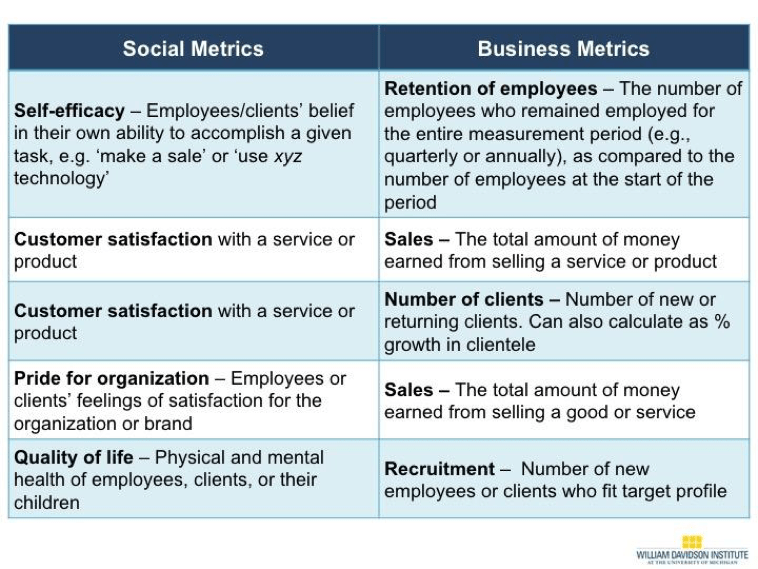Blog: How to Play Matchmaker to Social + Business Metrics
Monday, April 9, 2018

Women working with Chakipi Acceso in Peru. Image courtesy of Chakipi.
Note: The following post was co-written by Rebecca Baylor, Heather Esper and Yaquta Kanchwala Fatehi of WDI’s Performance Measurement Initiative. It was originally published on NextBillion.net, which is managed by WDI.
For many businesses and organizations, the idea of measuring their impacts is usually one of three things: scary, elusive or just plain boring. To make matters worse, evaluators have a rotten reputation for using too much annoying technical jargon. While there is some truth to these stereotypes, it doesn’t have to be all bad.
Our work demonstrates that it is possible to bridge the gap between people and metrics in a meaningful way.
In fact, our team at the William Davidson Institute recently released an impact report that demonstrates how we guided three organizations on how to demystify data collection of their social impacts. We worked with senior level leadership to develop strong surveys and data collection processes suited to their context. Perhaps more importantly, we openly discussed their measurement concerns and made explicit– dare we say, energetic– connections between their impact metrics and organizational strategy.
A key theme throughout this project was our goal to combine social and business metrics. When organizations – from enterprises to impact investors – actually track these types of combinations, which we refer to as “power couples,” they can absorb unique insights to solve key business challenges while communicating impact evidence. Through our work, we have encountered a number of social + business metric power couples that we’ve seen influence internal decision-making at organizations and improve results. Creating these power couples enables managers to more holistically harness their data to better meet business goals and increase intended impacts. For example, employee retention, an all-important business metric, may be affected by the impact that an organization has on the quality of life of their employees’ children, a social metric. This may be especially true for low- or middle-income employees.
Here are just a few common power couples that we identified during this project (detailed in the report) and others.

This list is just a start.
Selecting metrics takes time and patience. Indeed, finding the right metrics can be a lot like parenting. There isn’t one perfect formula and your strategy will likely evolve over time. However, we recommend businesses and investors interested in seeing social or environmental impact use some of the following strategies to make their job easier. We’re also including relevant resources to help you apply these strategies:
- Get Creative – Turns out, what works for one kid – or project– may not work for the next. Innovation isn’t optional, it’s required. To select the right combination of metrics, ask: What insights do we need? What are our key challenges? Use “pause and reflect” sessions to examine data across different teams. RESOURCE: FSG’s Intentional Group Learning Guide
- Pretest – Would you buy your child new sneakers without trying them on first? Didn’t think so! Don’t expect spectacular data insights to come from metrics you haven’t tested first. RESOURCE: Conducting a Successful Pretest
- Be Strategic – There is a reason why Child A doesn’t raise Child B. If you want business and social metrics that generate lessons and guide decision-making, you have to place parents – AKA: senior-level leadership – in the driver’s seat. The Boston Consulting Group’s article, Total Societal Impact: A New Lens for Strategy, offers an enlightening perspective on pursuing social impacts and business benefits simultaneously.
- Be Rigorous, Yet Right-sized – At bath time, one scrub behind the ear may not be enough to get the dirt away. Conversely, spending 3 hours soaked in suds is effective but unrealistic. MIT D-Lab’s Lean Research Framework is a great place to look for guiding principles to effective, right-sized research.
We hope these combinations excite you and inspire you to create a few social + business metrics of your own. Also, check out our case study for five lessons learned to accelerate successful impact measurement as an investor or investee. And if you enjoyed this post, share it, tweet it, or comment below! We’re also very curious about what social + business metric combinations have or haven’tworked for you. We look forward to hearing from you.
See? Impact measurement isn’t as scary (or as boring) as it may first seem.
Rebecca Baylor is a research associate for the Performance Measurement Initiative.
Heather Esper is the senior program manager for WDI’s Performance Measurement Initiative.
Yaquta Kanchwala Fatehi is a program manager for WDI’s Performance Measurement Initiative.
